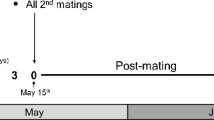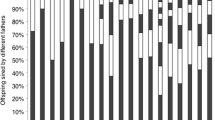Abstract.
Despite the likely importance of post-copulatory sexual selection in simultaneous hermaphrodites, the factors influencing sperm competition in these organisms are generally unknown. We have investigated the effects of dart-shooting, mating order, and several other predictors on the proportion of offspring fathered by penultimate (P n -1) and ultimate (P n ) sperm donors in multiply mated garden snails, Helix aspersa. While paternity ratios were biased towards the penultimate donor (mean P n -1=0.61), the magnitude of this advantage was dependent upon which of the two donors successfully darted the recipient. Mean P n -values increased from 0.17 when the recipient was hit by the penultimate donor to 0.39 when it was hit by the ultimate donor. Furthermore, the effect of the dart was more pronounced in the clutches of smaller recipients. From these results, and observations of live sperm in the storage organs, we propose a novel mechanism to explain the detected pattern of sperm utilization in helicid snails. Electronic supplementary material to this paper can be obtained by using the Springer LINK server located at http://dx.doi.org/10.1007/s00265-002-0519-6.
Similar content being viewed by others
Author information
Authors and Affiliations
Additional information
Electronic Publication
Rights and permissions
About this article
Cite this article
Rogers, D.W., Chase, R. Determinants of paternity in the garden snail Helix aspersa . Behav Ecol Sociobiol 52, 289–295 (2002). https://doi.org/10.1007/s00265-002-0519-6
Received:
Revised:
Accepted:
Issue Date:
DOI: https://doi.org/10.1007/s00265-002-0519-6




